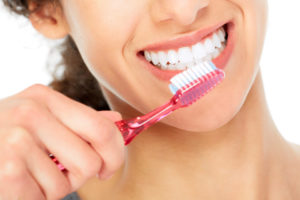Tooth plaque is a fact of life — everyone gets it. It’s the sticky film that forms when bacteria in your mouth build up on your teeth. When plaque hangs around for too long, your choppers pay the price. It eats at them and makes them weak. That leads to decay and gum disease. You can’t evict bacteria from your mouth (some kinds are actually good for you), but you can nip plaque buildup with these five tips.
1. Brush at least twice a day, the right way. 
You know you should do it, but how often? “Ideally, we want everyone to brush after each meal to remove plaque as soon as it develops,”. It’s especially important to get your bedtime brushing in, because without it, plaque sits on your teeth all night long. Use a soft-bristled toothbrush. Hard bristles can be rough on your gums. Make sure to replace your toothbrush every 3-4 months. If it gets too worn, it won’t work well.
To make sure you’re getting the most out of each trip to the sink:
- Hold your toothbrush at a 45-degree angle to your gums while you brush.
- Use gentle, circular strokes about a tooth wide.
- Cover your whole mouth — outer and inner surfaces, and tops of your teeth.
- Brush your tongue to scrape away bacteria and freshen your breath.
- Spend 2 full minutes on brushing.
2. Clean between your teeth.
Your teeth aren’t the only places where plaque gathers. It also hides in the spaces between your teeth. Floss or other tools that reach that are key.
“Tooth brushing alone doesn’t remove plaque from between the teeth,”.You should floss at least once each day. If wrapping floss around your fingers isn’t for you, there are other options that are just as effective, including:
- Dental picks
- Pre-threaded flossers
- Small, straight brushes that fit between your teeth
- Water flossers
- Wooden plaque removers
There’s no right or wrong time to clean between your teeth, either. You can do it before you brush or after — or carve out time for a whole separate floss fest. Just make sure you do it.
3. Swish with mouthwash.
For many people, antibacterial mouthwash can be another option in their plaque prevention toolkit. “Mouthwash generally helps loosen plaque, making it easier to remove,”. But a type that’s good for someone else may not be good for you. Typically dentists recommend a mouthwash based on a patient’s needs. You might be a good candidate if you’re prone to cavities,or if you have gum inflammation or dry mouth. Some mouthwashes with alcohol can dry your mouth out. That’s not good for plaque prevention. Your saliva helps keep your mouth healthy. Dry mouth can lead to buildup of a type of plaque called sticky plaque, which is harder to clean. Talk to your dentist about which mouthwash might be right for you.
4. Skimp on the sugar and starch.
When you finish eating, bacteria rush to the sugar left in your mouth and feed on it. The more sugary your food, the more bacteria there are to deal with when you brush. Sugary foods and acidic foods cause decay. Eat them sparingly, and you’ll avoid problems. The worst offenders include:
- Starchy foods like potato chips and breads
- Sticky candies that cling to your teeth
- Carbonated soft drinks
- Alcohol
When you do treat yourself to one of these, drink plenty of water afterward to wash away bits of food and keep your mouth moist. Try not to snack between meals, and brush after you eat to keep your whites pearly. If you aren’t near your toothbrush after a meal, chew sugarless gum.
5. Visit your dentist often.
Most of your plaque prevention happens in your everyday routine. Still, it’s important to see your dentist twice a year, too. No matter how great a job you’re doing at home, there are some areas that are difficult to reach and clean properly, like under the gums or behind the second molars. Besides cleaning the spots you might have missed, your dentist can tweak your tooth techniques and catch any issues early, before they become bigger problems. Keeping tabs on your oral health can ensure your smile will stay bright for the long run.



